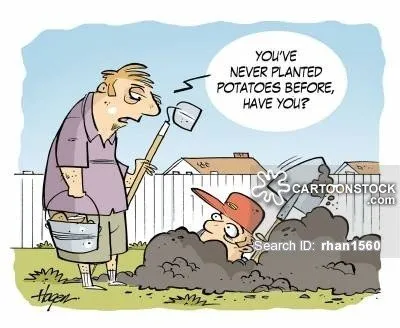& the tower-growing myth of continued hilling
This is something I have only recently come to understand – there is NO benefit to the continued hilling of soil/mulch/whatever up the stems of potatoes in the sense that it is establishing the growth of more potatoes!
All those ‘potato towers’ shown to be such wonderful ways to get bumper crops … are simply perpetuating a myth. Below is just one such example (see step five), but there are numerous other ones to be found throughout the internet.

image source
A potato, while belonging to the same family as the tomato (and the aubergine, btw) – classification Solanaceae (nightshades) – does not grow in the same manner. Potatoes, if their stems are covered, will not produce new growth up those stems. They grow tubers, known as ‘stem tubers’ (or more technically stolons) from their thickened rhizomes (aka underground stems).(1) The new tubers (potatoes, as we know them) form as nodules on the ends of roots (rhizomes).

image source
Traditionally, people have used the trench & hilling method, which is just as it sounds – a row trench is dug, the seeded (chitted) potatoes are placed along the trench, and then covered and the soil then hilled up; and throughout the growing season more hilling is done as the potato stems heighten. I believe this has created the myth that the hilling leads to the plant growing more potatoes up its stem, when in fact it is because as the potatoes grow they may push their way to the surface and then need covering to prevent exposure to the sun whereby they are likely to turn green, and so become toxic to eat. Soil depth and friability also come into play as to how much the potatoes try and push their way to the surface.
I am not trying to diss the tower-growing methods, but I do think the way they are used needs to change. Personally, I’ve been growing potatoes for the last couple of years in tyres (details of which I’ll share in another article), one form of tower growing. I believe that if a tower is first filled to near the top with the soil medium, then the seed potatoes planted, and lastly a good layer of soil & mulch to cover it is a far more effective way to utilise the tower space.
In this way, the new-forming potatoes have plenty of space in which to grow downwards beneath the surface, with just an eye kept on the surface layer in case any potatoes do push their way to the top – then they can be protected from the sun with more soil or mulch as necessary; and the stems may need a bit of propping up as they get heavier. Mulching also helps retain moisture around the plant.
I do hope I have managed to dispel the hilling myth, and that as food-producing gardeners we can begin to apply more accurate and therefore more efficient growing methods to our crops.

image source
references:

(graphic courtesy of my artistic daughter, @kiwisims)